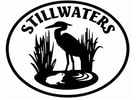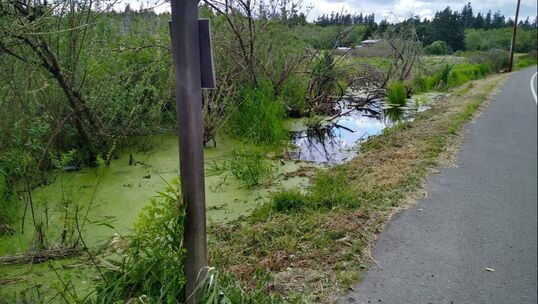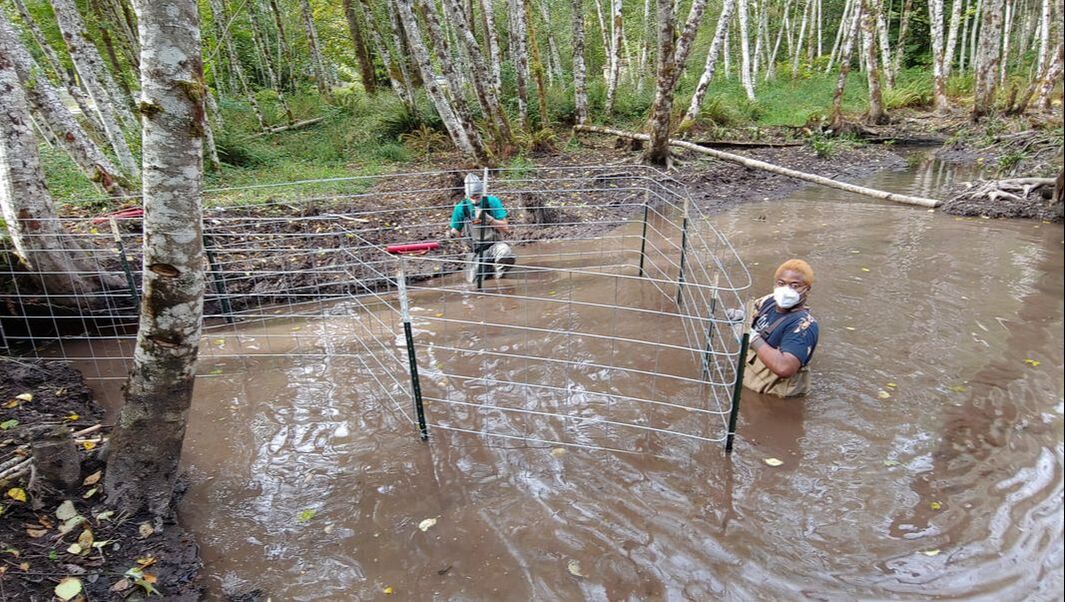Solution to beaver flooding Barber Cut Off road is in sight
Folks familiar with Barber Cut Off Road are no doubt also familiar with signs that appear most winters alerting drivers to “Water over Roadway” when Carpenter Creek overflows the road north of Gordon Elementary. Beaver activity often blocks the culvert there and on Tuckerman Ave (AKA Carpenter Lane), requiring multiple visits from county road crews over the years to clear the blockages.
In Spring of 2021, beavers constructed dams on undeveloped properties between these culverts, backing up the creek to almost road level. Locals concerned about what such high water in May would mean once the fall rains started contacted county and state agencies to find a long-term solution. The county alerted the property owners, who readily agreed to allow Beavers Northwest, a non-profit specializing in non-lethal, long-term solutions to human/beaver conflicts, to visit the dams.
Leaving beaver dams in place while installing devices to manage water levels behind them is the preferred solution. Removing problem beavers (trapping) is usually a short-term solution because property attractive to one beaver family will undoubtedly attract more. But more importantly, beaver dams can provide numerous benefits to a watershed and the people who live there.
Historically, Kitsap lowland streams had numerous beaver dams storing winter rains that would otherwise flow directly into Puget Sound within a matter of days. Thus, beavers help recharge the aquifers that supply Kitsap homes with water. Without snow-covered peaks to provide melt water during summer months, many Kitsap streams can and do run dry. By releasing water more gradually, beaver dams provide stream habitat year around and their ponds are a refuge for wildlife.
However, beaver activity is no small problem for people whose homes are flooded and where high water can undermine roadbeds. Fortunately, Beavers Northwest’s solutions can manage beaver pond levels to prevent such problems while allowing the beavers to remain in place. Unfortunately, when their consultant arrived at the Carpenter Creek dam site this September, someone had just illegally taken matters into their own hands by trespassing and breaching the bigger dam.
This is a serious problem. First, long-term solutions cannot be implemented without an intact dam to work with. Second, tampering with beaver dams is illegal without a Hydraulic Project Approval from WDFW. This permit is required because disrupting dams in the wrong way at the wrong time can be detrimental to salmon. In this case, draining the beaver pond at the end of a dry summer jeopardized young salmonids living there and released mud over the clean gravel downstream just before adult coho return to spawn. Ironically, some of the best fish rearing habitat in the creek has been documented in this area (see https://wildfishconservancy.org/resources/maps).
Beavers Northwest will return when the beavers inevitably rebuild. Meanwhile, folks that have problems with beaver dams should contact Beavers Northwest (http://www.beaversnw.org/) and WDFW for advice before acting.
In Spring of 2021, beavers constructed dams on undeveloped properties between these culverts, backing up the creek to almost road level. Locals concerned about what such high water in May would mean once the fall rains started contacted county and state agencies to find a long-term solution. The county alerted the property owners, who readily agreed to allow Beavers Northwest, a non-profit specializing in non-lethal, long-term solutions to human/beaver conflicts, to visit the dams.
Leaving beaver dams in place while installing devices to manage water levels behind them is the preferred solution. Removing problem beavers (trapping) is usually a short-term solution because property attractive to one beaver family will undoubtedly attract more. But more importantly, beaver dams can provide numerous benefits to a watershed and the people who live there.
Historically, Kitsap lowland streams had numerous beaver dams storing winter rains that would otherwise flow directly into Puget Sound within a matter of days. Thus, beavers help recharge the aquifers that supply Kitsap homes with water. Without snow-covered peaks to provide melt water during summer months, many Kitsap streams can and do run dry. By releasing water more gradually, beaver dams provide stream habitat year around and their ponds are a refuge for wildlife.
However, beaver activity is no small problem for people whose homes are flooded and where high water can undermine roadbeds. Fortunately, Beavers Northwest’s solutions can manage beaver pond levels to prevent such problems while allowing the beavers to remain in place. Unfortunately, when their consultant arrived at the Carpenter Creek dam site this September, someone had just illegally taken matters into their own hands by trespassing and breaching the bigger dam.
This is a serious problem. First, long-term solutions cannot be implemented without an intact dam to work with. Second, tampering with beaver dams is illegal without a Hydraulic Project Approval from WDFW. This permit is required because disrupting dams in the wrong way at the wrong time can be detrimental to salmon. In this case, draining the beaver pond at the end of a dry summer jeopardized young salmonids living there and released mud over the clean gravel downstream just before adult coho return to spawn. Ironically, some of the best fish rearing habitat in the creek has been documented in this area (see https://wildfishconservancy.org/resources/maps).
Beavers Northwest will return when the beavers inevitably rebuild. Meanwhile, folks that have problems with beaver dams should contact Beavers Northwest (http://www.beaversnw.org/) and WDFW for advice before acting.



